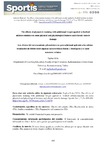Mostrar o rexistro simple do ítem
The Effects of Plyometric Training With Additional Weight Applied to Football Athletes-Students on Some Physical and Physiological Features and Chronic Muscle Damage
| dc.contributor.author | Şirin, Tayfun | |
| dc.date.accessioned | 2022-03-21T16:41:54Z | |
| dc.date.available | 2022-03-21T16:41:54Z | |
| dc.date.issued | 2021-08-06 | |
| dc.identifier.citation | Şirin, T. (2021). The effects of plyometric training with additional weight applied to football athletes-students on some physical and physiological features and chronic muscle damage: . Sportis. Scientific Technical Journal of School Sport, Physical Education and Psychomotricity, 7(3), 405-424. https://doi.org/10.17979/sportis.2021.7.3.8579 | |
| dc.identifier.issn | 2386-8333 | |
| dc.identifier.uri | http://hdl.handle.net/2183/30084 | |
| dc.description.abstract | [Abstract] The aim of this study is to investigate the effects of plyometric training with additional weight on physical performance and muscle damage findings in faculty of sports sciences athlete-students. Physical performance tests and blood samples of the athlete-students (male 23.41 ± 3.2 years old) were collected both from sample and the control groups at the first week of the study and at the last training of the twelfth week. During the study, plyometric training programs were applied to the additional weight group (AWG) and no additional weight group (AG). By the end of first and twelfth week, players’ BMI and body fat percentage tests were applied together with the physical tests of shuttle, yoyo, vertical jump, horizontal jump, agility and sprint performance tests. Blood samples were also taken to check muscle damage control markers (CK and LDH). Results: According to the results of tests performed at the end of first and twelfth weeks’ plyometric trainings on group with additional weight group (AWG), shuttle, yoyo and horizontal jumping were found to be significantly increased, while sprint performance, BMI and body fat performance tests were significantly decreased. The test results of the group without additional weight (AG) was; significant increase in shuttle, yoyo and vertical jump while significant decrease in sprint performance and fat %. By the end of twelve week plyometric trainings, no muscle damage has been observed in (AWG), CK pre-training (229,00 ± 155,25) and post training values (242,33 ± 193,67) and LDH pre-training (169,75 ± 40,85) and post-training (174,33 ± 39,12) values. As a result of the study, 12-week plyometric training with additional weight applied to football athletes-students not only increased their physical performance, but also muscle damage (CK and LDH) was not observed. | |
| dc.description.abstract | [Resumen] El objetivo de este estudio es investigar los efectos del entrenamiento pliométrico con peso adicional sobre el rendimiento físico y los hallazgos de daño muscular facultad de ciencias del deporte deportistas estudiantes. Se recogieron pruebas de rendimiento físico y muestras de sangre de los estudiantes-deportistas (hombres 23,41 ± 3,2 años) tanto de los grupos de muestra como de control en la primera semana del estudio y en el último entrenamiento de la duodécima semana. Durante el estudio, se aplicaron programas de entrenamiento pliométrico al grupo de peso adicional (AWG) y grupo sin peso adicional (AG). Al final de la primera y duodécima semana, se aplicaron las pruebas de IMC y porcentaje de grasa corporal de los jugadores junto con las pruebas físicas de lanzadera, yoyo, salto vertical, salto horizontal, agilidad y pruebas de rendimiento de velocidad. También se tomaron muestras de sangre para verificar los marcadores de control de daño muscular (CK y LDH). De acuerdo con los resultados de las pruebas realizadas al final de los entrenamientos pliométricos de la primera y la duodécima semana en el grupo con grupo de peso adicional (AWG), prueba de lanzadera, el yoyo y el salto horizontal aumentaron significativamente, mientras que el rendimiento en esprint, el IMC y el las pruebas de rendimiento de grasas se redujeron significativamente. Los resultados de la prueba del grupo sin peso adicional (AG) fue; aumento significativo pruebas físicas de lanzadera yoyo y salto vertical mientras que una disminución significativa en el rendimiento del sprint y el porcentaje de grasa Al final de los entrenamientos pliométricos de doce semanas, no se ha observado daño muscular en (AWG), CK pre entrenamiento (229,00 ± 155,25) y valores posteriores al entrenamiento (242,33 ± 193,67) y valores de LDH pre-entrenamiento (169,75 ± 40,85) y post-entrenamiento (174,33 ± 39,12). Como resultado del estudio, el entrenamiento pliométrico de 12 semanas con peso adicional aplicado a jugadores atletas-estudiantes de fútbol no solo aumentó su rendimiento físico, sino que tampoco se observó daño muscular (CK y LDH). | |
| dc.language.iso | eng | |
| dc.publisher | Universidade da Coruña | |
| dc.relation.uri | https://doi.org/10.17979/sportis.2021.7.3.8579 | |
| dc.rights | Atribución-NoComercial-SinDerivadas 4.0 Internacional (CC BY-NC-ND 4.0) | |
| dc.rights.uri | https://creativecommons.org/licenses/by-nc-nd/4.0 | |
| dc.subject | Pliometría | |
| dc.subject | Peso adicional | |
| dc.subject | Estudiantes-deportistas | |
| dc.subject | Ejercicio físico | |
| dc.subject | Plyometric | |
| dc.subject | Additional weight | |
| dc.subject | Athlete-students | |
| dc.subject | Physical exercise | |
| dc.title | The Effects of Plyometric Training With Additional Weight Applied to Football Athletes-Students on Some Physical and Physiological Features and Chronic Muscle Damage | |
| dc.title.alternative | Los efectos del entrenamiento pliométrico con peso adicional aplicado a los atletas-estudiantes de fútbol sobre algunas características físicas y fisiológicas y el daño muscular crónico | |
| dc.type | journal article | |
| dc.rights.accessRights | open access | |
| dc.date.updated | 2022-03-21T16:31:07Z | |
| UDC.journalTitle | Sportis. Scientific Journal of School Sport, Physical Education and Psychomotricity | |
| UDC.volume | 7 | |
| UDC.issue | 3 | |
| UDC.startPage | 405 | |
| UDC.endPage | 424 | |
| dc.identifier.doi | 10.17979/sportis.2021.7.3.8579 |






